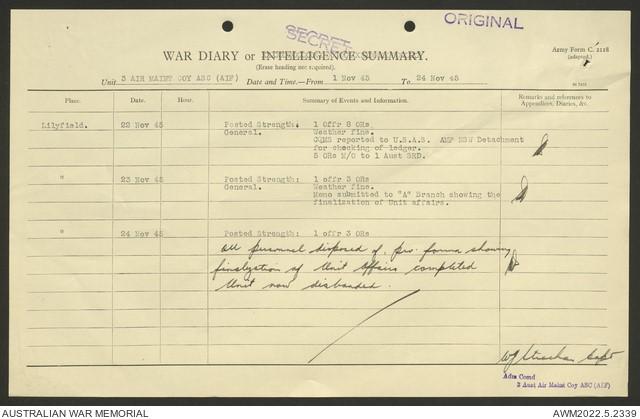Delivering the goods in hard places: the work of 3 Air Maintenance Company during the Second World War
Personnel of 3 Air Maintenance Company (3AMC) at work arranging cargo supplies, at their Nadzab base in New Guinea. Photographer unknown. AWM073392
In New Guinea during the Second World War, non-combat support units delivered essential supplies including weapons, rations, and medical supplies to Allied combat forces in remote and demanding terrain. In many areas, road access was impossible, and attacks by Japanese forces made maritime transport risky until late 1942. As a solution, the Australian Army formed Air Maintenance Companies which packaged and distributed supplies from cargo planes to ground-based personnel.
3 Australian Air Maintenance Company (3AMC) was based at Nadzab in New Guinea from 1943 until returning to Australia in October 1944.

3AMC’s unit war diary shows its date of formation
3AMC’s supply delivery work started with the American method of using DC-3 Dakota aircraft with the main side-door removed. Crews flew to the area marked for a supply drop, where the pilot made repeated passes over the drop zone while tilting the plane on a steep sideways angle, while crew members pushed supplies out of the aircraft. One 3AMC veteran recalled witnessing crew members fall out of a plane and into the jungle.
As well as there being few handholds to grip for safety, there were no parachutes for the supplies. After many rations of biscuits were broken into small pieces, the planes were dubbed “Biscuit Bombers”. Injuries, accidental deaths, and the increasingly expensive loss of supplies led to the Australian innovation of the “storepedo”: a set of supplies wrapped and cushioned before being placed inside a container with an outer casing resembling a torpedo. Used with a hessian parachute to slow cargo descent, the use of storepedos significantly improved the number of successful deliveries. In addition to deliveries for combat units, especially the Australian Army's 7 Division, 3AMC assisted in the delivery of Red Cross and Comfort Fund packages, and medical supplies for 111 Casualty Clearing Station.
Members of 3AMC at Nadzab base prepare supplies for delivery to forward areas on the ground in New Guinea, May 1944. The men on the left side in photo carry an Australian-made storepedo, while the men on the right carry an American-style package. Photographer unknown. AWM073397
At 3AMC's inland base at Nadzab, a nearby American-built airstrip was used by cargo plane crews. The two nations' personnel worked together on delivery missions, and occasionally pooled resources to organise concerts for personnel at the base.
As 1944 progressed, an increase in the use of truck convoys to deliver supplies led to less frequent flights, and by October 3AMC was back in Australia, based in French's Forest in northern Sydney.
The unit’s officers needed to find work for the men while the war continued. One option was to volunteer them for work at Sydney’s cargo wharves. The labourers already there – the wharfies – weren’t keen on the newcomers and there was a status issue, as some had made a point of not recognising the men of 3AMC as genuine soldiers. After years of hard overseas service, this was a serious cause for offence.
Accommodation was another issue. The military camp handed over for 3AMC's use had been occupied by American units who had left unfamiliar items behind, and the Australians returning to Sydney were unimpressed with their new home. Wartime security measures also restricted communication; although they were back in Australia, soldiers often had minimal communication with their families. It wasn’t until after late November 1945, when the unit was officially disbanded, that veterans could start building their post-war lives.

The last page of 3AMC’s unit diary shows its date of disbanding.
The personnel of 3AMC serving in New Guinea during the South-West Pacific campaign routinely delivered masses of essential supplies in challenging and dangerous conditions. This work made an important contribution to Allied success. Innovations to improve packaging of supplies proved helpful to combat units and non-combat recipients. On returning home, 3AMC’s personnel found new difficulties in work, lack of recognition, and accommodation. Despite these disappointments, they all had reasons to be very proud of their contributions to Australia's war work.

